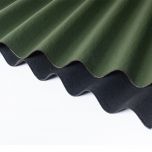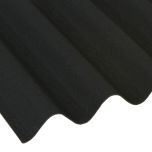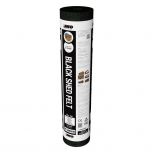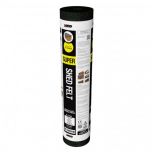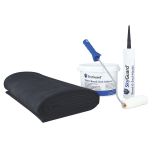A Guide to the Best Shed Roofing Materials
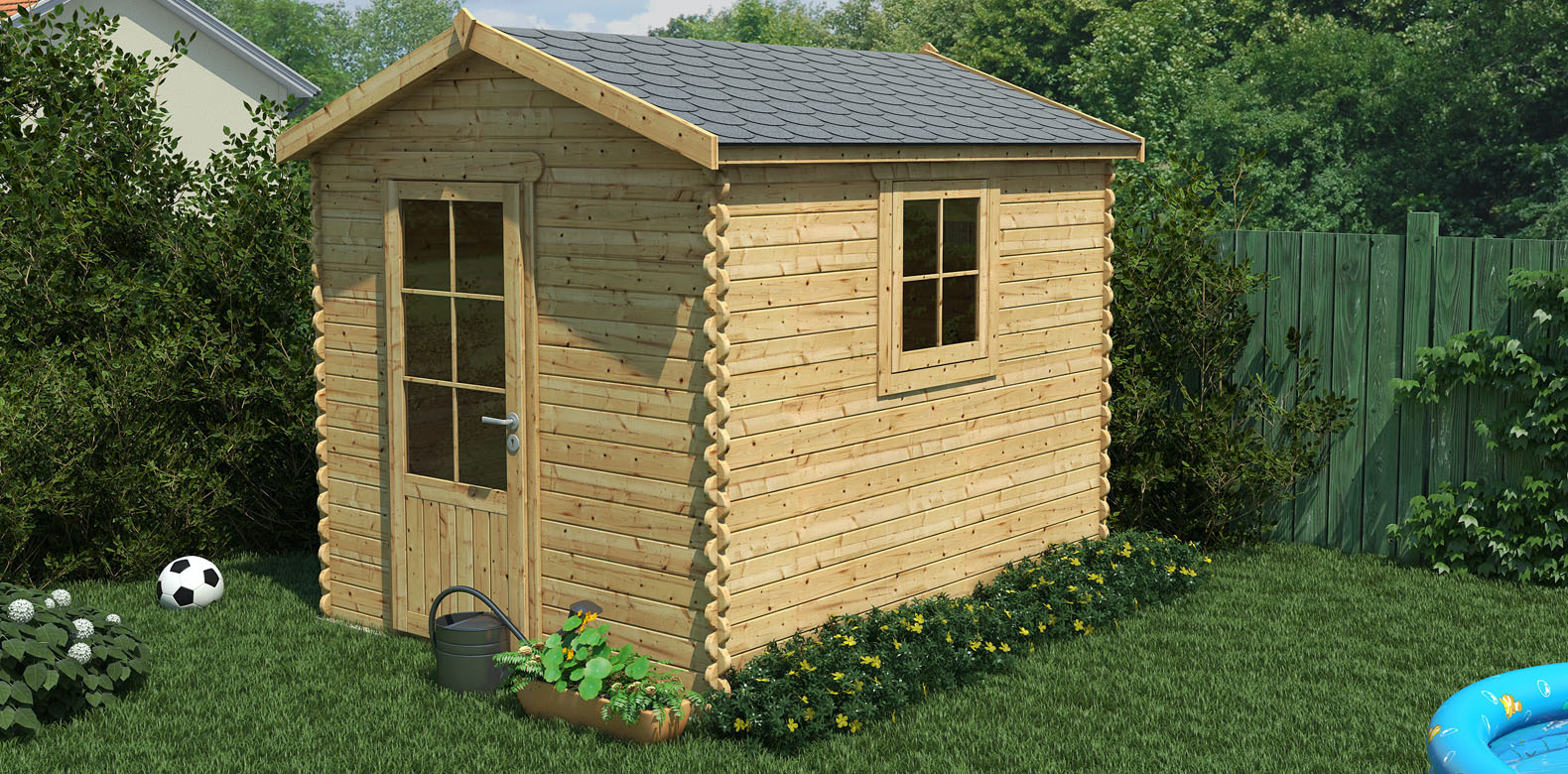
Whether you’re building a new garden shed or simply renovating an existing one, its roof is one of the most important choices you’ll need to make. After all, it’s one of the most important elements which protects your shed from the elements, so its new roof will need to be durable and reliable as well as visually appealing and cost effective.
There is however an absolute abundance of shed roofing materials on the market, and it can be difficult to choose between them. That’s why we’ve written this handy guide to help you find out more about the unique advantages of each that may well make one option stand out as perfect for your needs.
This guide will not only take a look at each of the most popular shed roofing materials, noting their pros and cons, but we’ll also speak about the type of shed each material is most suited to, hopefully giving you the best idea of which option is right for your project.
Table of Contents
Pitched Roofing Materials
Whether your shed or garden building features a standard apex roof or a striking, modern single slope, we’ve got a wide range of materials to suit you.
Tiles and Shingles
Roof tiles and roof shingles are some of the most popular shed roof coverings, thanks to their durability and the refined appearance they lend a garden shed. A tiled roof transforms your garden building into a smaller structure that better matches the aesthetic of your home.
Clay Roof Tiles
For larger sheds, especially those made from sturdier materials such as brick, clay roof tiles are an excellent option. Offering sublime aesthetics that will complement any home and garden, these tiles come in a wide range of designs, styles, and finishes. So, you’re sure to find the perfect clay tiles to suit your tastes and property.
Clay tiles are some of the most expensive roofing materials, but in return for that added investment you’ll enjoy an unmatched, traditional appearance with superb durability. Thanks to innovative manufacturing techniques, installing clay tiles has also become much easier over the years. While fixing clips and numerous other accessories are still required, newer, more intuitive designs have made the process more streamlined than ever before.
Clay tiles boast one of the longest lifespans of any roofing material. They’ve been used in construction for centuries, and it is not at all unusual for them to last for 60 years before requiring work or replacement. Extremely durable, they are resistant to storms, gales and copious amounts of snow and ice, providing your roof with year-round protection. However, due to their weight, they are not suited to smaller sheds or garden buildings, or those constructed from materials such as lightweight timber.
Felt Shingles
Felt shingles are another very commonly used shed roofing material. Popular on garden structures up and down the country, this roofing option is highly sought after due to the wide range of colours and finishes available. The sheer range of aesthetic options makes felt shingles one of the most diverse materials you could use to cover your shed roof.
Felt shingles are also popular due to their low cost, which makes them ideal for projects where budget is a concern. They are also exceptionally easy to install and have been designed to streamline the process taking as little time and using as few tools as possible. These shingles can be successfully fixed to your shed roof in a matter of hours using just a hammer and some fixings.
Despite their low cost, you can count on felt shingles lasting for around 20 years. While they by no means have the greatest longevity of the shed roofing materials discussed in this guide, they still boast two decades of low maintenance protection. Plus, as they’re designed to be simple to install, should any individual felt shingles ever need replacing, it will be a quick and easy job. Their durability also rivals other materials, with terrific weather resistance and greater resistance to impact.
Wood Shingles
Another favourite for many, wood shingles can be made out of several different kinds of wood, including cedar, oak and redwood. The appearance of wood shingles is therefore incredibly diverse, enjoying the unique natural finish shared by real wood. Achieving an excellent balance between solid performance and an unmistakably natural aesthetic that will suit many gardens, wood shingles are a very reliable shed roofing option.
The price of wood shingles usually depends on the type of wood used, with more ‘premium’ species such as oak often being more expensive, though their aesthetics and durability are more than worth the extra cost to many. Like felt, the installation of wooden shingles is usually quite straightforward, needing only a hammer and some nails.
The lifespan of wood shingles again varies based on the type of wood, as does the durability. A shingle made of high-quality wood can last from 30-40 years if installed correctly. Their durability is also considerable, able to withstand intense weather conditions, though they can sometimes be prone to slightly changing shape as the temperature rises and falls.
Roofing Sheets
Roofing sheets are favoured by homeowners thanks to their superb protection, aesthetics and just how easy they are to install yourself. Instead of many individual tiles, only a few sheets are needed to cover the same roof area. Perfect for larger sheds and garden buildings.
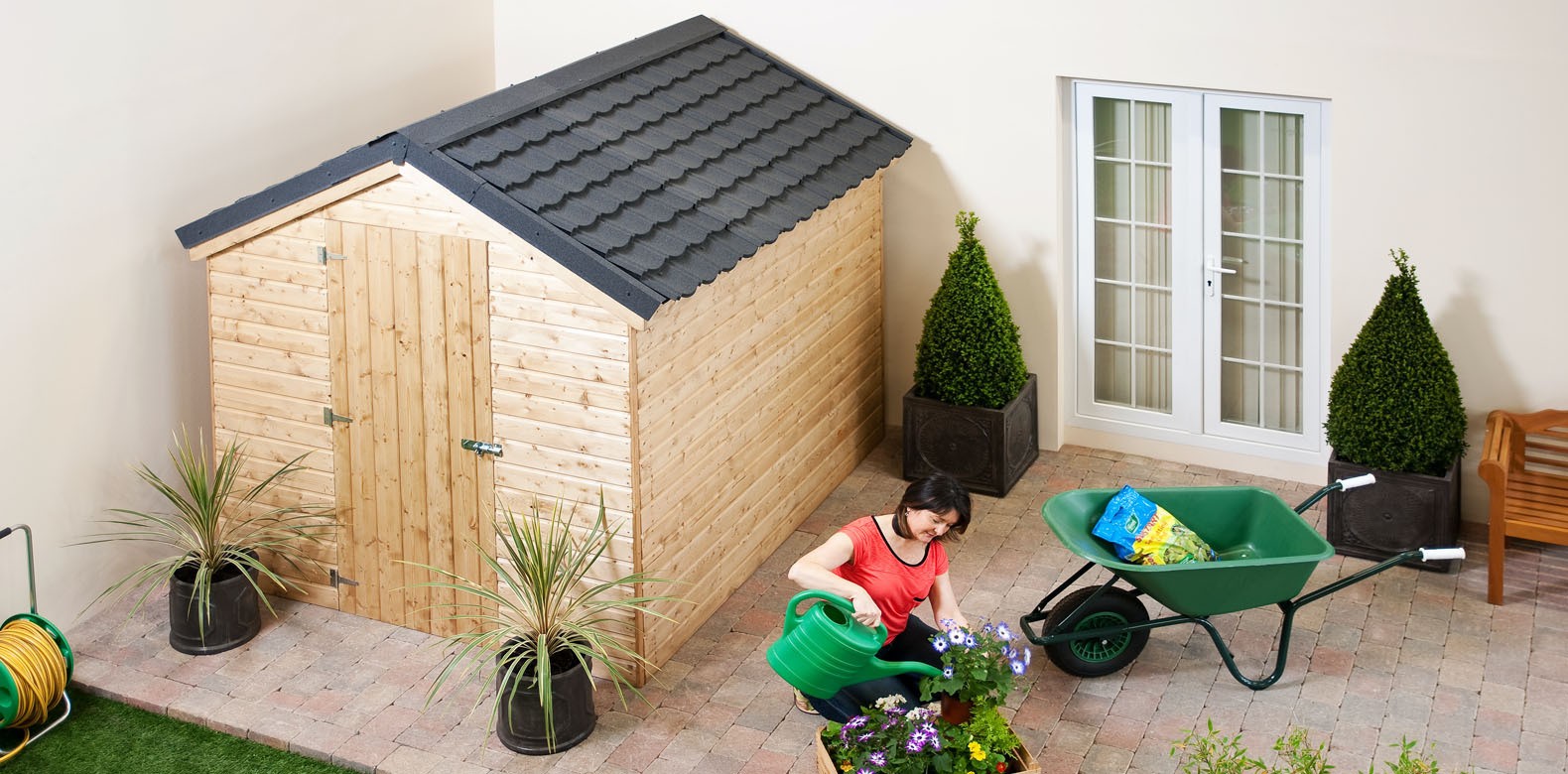
Bitumen
Bitumen roof sheets are perhaps the most popular shed roofing material amongst our customers. Perfect for a wide range of different garden structures, bitumen sheets mostly come with a standard corrugated profile. Available in a vast selection of colours and finishes, you’re sure to find a style to suit you.
Bitumen roofing sheets are exceptionally cost-effective, starting at just £5 per square metre. Despite their low cost, they’re highly durable and very simple to install yourself. All you’ll need are a few basic tools as well as fixings and fitting these sheets will be done in no time. Often cut to specific sizes, you may find yourself only needing one or two sheets to effectively cover your shed roof.
Bitumen sheeting has a lifespan of around 20 years, and this is a major reason behind its popularity – for its price, it is extremely durable and aesthetically pleasing and also requires very little maintenance once installed. Highly resistant to inclement weather, these sheets are also simple to replace at the end of their lifespan.
We've just launched our very own corrugated shed roof kit. Designed to cover apex or pent shed roofs, our kits use high-quality Coroline bitumen sheets and come in a range of common shed roof sizes.
Metal
Metal roof sheets are another form of shed roof covering that’s incredibly popular among homeowners. Available as both box profile and corrugated sheets, steel roofing boasts exceptional durability and resistance to the weather. While metal roofing sheets do not have the same broad selection of styles and finishes as clay tiles or felt shingles, you still have a number of colours and profiles to choose from.
Metal roofing sheets are a reasonably priced option that combines a sleek, modern aesthetic with excellent strength. Installation is also relatively simple, with only a few basic tools and accessories required to carry out the process successfully. You may also only find yourself requiring a couple of sheets to cover your shed, saving you time and money.
Metal sheeting can last for up to 25 years if installed and maintained properly, which is a key factor behind its popularity. Requiring relatively little work once installed when compared to other roofing materials and is resistant to adverse weather, providing long-lasting protection for your shed.
Polycarbonate
A relatively new product on the market, polycarbonate roofing sheets are perfect for simple, lightweight garden structures such as sheds, lean-tos and canopies. Produced in several different styles and finishes, polycarbonate roofing is rapidly growing in popularity as a highly cost-effective alternative to more traditional roofing options.
For a low price, polycarbonate provides many of the benefits of other shed roofing materials, along with some unique advantages such as allowing plenty of natural light into the structure when you choose a clear finish. Installation is also intuitive and straightforward and can be carried out with just a few tools and accessories. The versatility of this material also means it can be purchased in a range of different sizes, including a bespoke cut to size service, which will give you the exact sizes needed for your project, minimising hassle and eliminating the need to cut sheets on-site.
Polycarbonate sheets also boast excellent impact resistance, making them a perfect shed roof covering in heavily-wooded areas or anywhere else where there is a risk of falling debris. Also, highly scratch-resistant, animals such as cats and birds can pass over it without leaving many marks, and falling hail will rarely leave a trace.
Flat Roofing Materials
Flat shed roofs can often be plagued by nightmare leaks and other issues. That’s why we stock a wide variety of high-quality flat roof materials that are easy to install and will truly stand the test of time.
EPDM Rubber Roofing
EPDM Rubber is another increasingly popular choice of shed roof covering. While not as traditional as tiles or felt roofing, it is nevertheless an excellent solution in its own right. Unlike many shed roof materials, EPDM can be used on flat roofs, and possesses several benefits that make it perfect for non-pitched structures.
EPDM rubber roofing offers many of the advantages homeowners are looking for when deciding between shed roofing materials. It is highly cost-effective, and incredibly simple to install yourself. Most manufacturers provide their own easy-to-follow installation guides. Lifespans can vary, but 50 years is not at all unheard of for EPDM roofs.
What’s more, EPDM rubber is also exceptionally durable, able to resist heavy impacts as well as warping or tears. EPDM is also completely waterproof, and since it is installed in one large sheet, there are no seams to provide weak points for water to penetrate into the structure below. While a rubber roof is not as aesthetically pleasing as many of the pitched roofing options, EPDM still provides a clean finish and boasts exceptional performance.
Shed Felt
Shed felt is the classic flat shed roof covering. Available in a number of styles and colours, it’s simple to pick out an aesthetic to suit your home and garden. Its near unrivalled cost-effectiveness is perhaps the roofing felt’s greatest advantage, as well as how simple to install and maintain it is.
Applying felt to a shed roof is a simple process, and roof felt can be secured onto your shed very quickly using only the most basic hand tools. The lifespan of your shed roofing felt can vary from around 10 years up to 30, depending on correct installation and exposure to extreme weather.
A felt roof is durable and will provide effective protection against the elements, particularly water ingress. However, felt is not the most durable shed roofing material, and can experience significant wear and tear over time, as well as being susceptible to damage during extreme weather. Roofing felt will also not provide the same level of impact resistance as EPDM rubber. However, its low price and simple installation still attracts many homeowners to the material.
What is the Easiest Shed Roof Covering to Install?
From a DIYers perspective, shed felt is likely the easiest and, more to the point, the quickest material to fit. Supplied in rolls, felt need only be cut to the correct size, adhered onto the shed roof deck using ‘over the counter’ adhesive and finished with nails. Capping the shed at the apex requires another length of felt, but other than that the whole process can take as little as a few hours – depending on the size of your shed.
So Which Shed Roofing Material Is Right For You?
Choosing the right material for your shed roof all comes down to your personal requirements, and what you want most from your shed roof. If you’re looking for a cost-effective material that offers all-round performance on roofs with pitches as low as 5°, you can’t go wrong with bitumen roofing sheets. Or, if additional durability is your primary concern, then choose metal roofing sheets. If you’ve got a flat roof, EPDM Rubber combines simple installation with incredible durability and longevity. But if you’re looking to maximise visual appeal with a garden shed that matches the beauty of your home, opt for clay roof tiles.
As you can see, if you’re re-roofing a shed, there’s no end to the high-quality options available to you. This is because each and every homeowner will have different requirements for their shed roof, so it’s important to choose the material that’s right for you. We hope our guide has been a big help in choosing the right shed roof covering for your project.
If you’re still unsure about what to choose, or you have any more questions, be sure to get in touch with our award-winning customer service team. You can reach them via telephone on 01295 565 565, via email at [email protected] or by using the handy live chat on our website. With over 40 years of experience in all things DIY and roofing, they’re sure to be able to help you get your project underway.
